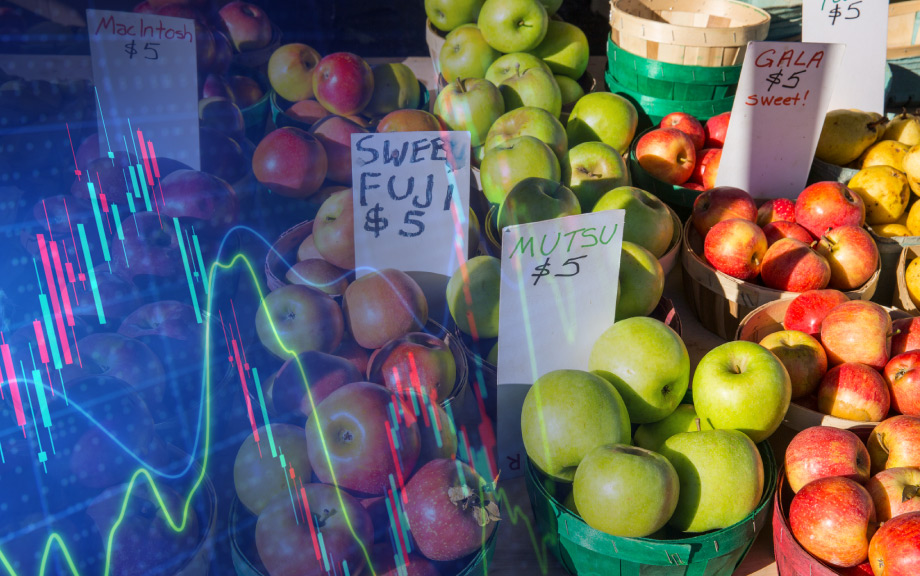
In this recurring column, Kartik Athreya, the New York Fed’s Director of Research, draws connections between broader economic policy issues and our everyday lives.
A type of statement one frequently hears, and that I myself sometimes make, is that “inflation is being driven by item X being stuck in a supply-chain mess,” or “item Y being suddenly in great demand,” and so on.
Such statements are a natural instinct for many of us—perhaps because they’re empirically reasonable. But these statements are not automatic—they are not always or necessarily true. Instead, our ability to make them reflects a deeper policy success in which inflation is generally, but imperfectly, controlled. Paradoxically, it is good inflation control that lets us speak of deviations in inflation from the norm as being “driven” by some one-off force like an earthquake or a supply chain snafu.
Think of a world where people do just two things: eat apples and take boat rides (representing broader sectors in our economy like “goods” and “services”). Let’s say apples are $1 each and boat rides are $10 per ride. Now let’s say there’s a huge frost that kills off half of the apple trees. Our intuition tells us that whatever else transpires, apples must get pricier in terms of how many boat rides you have to give up to get one—after all, apples are now much harder to find relative to the one other item that people consume in our imagined world. But, if we price things like we do in our real world—in dollars—it doesn’t have to be that the dollar price of apples rises.
This probably sounds strange, so let me offer some examples. Let’s say that following the frost, apples did get pricier in dollar terms—rising to $2 per apple. That seems directionally correct. But now imagine that boat rides also doubled in price. Has anything actually changed in terms of how much of one of these things you must give up to get the other? Clearly not. And that does not look like what we’d expect to ensue from the post-frost situation—namely, apples are not more precious than before in any meaningful manner.
Now imagine that instead of rising, apples prices stayed at $1, but the price of boat rides fell. Now each apple you eat does mean giving up more boat rides than before. So, apples have indeed gotten more valuable—in very real terms—in the wake of the frost, just as we would expect.
Or imagine yet another case: that apple and boat-ride prices both fall, but boat-ride prices fall by more! This too would deliver us an increase in the relative value of apples.
In the last two examples, the market delivered a relative-price hike for apples, just as we know it must. But in both cases, it did so along with a deflation in the wake of the apple frost, as the dollar price of neither item rose, and that of at least one fell.
Clearly, then, there is no necessary connection between things that change the scarcity of an item (here, apples) and the overall inflation rate. Our examples clarify instead that the change in the dollar price of apples (or boat rides) really could go any which way, so long as apple prices rise relative to boat rides.
Yet none of the changes I’ve described seem very natural. So, what gives? Well, mechanically, we know that for apple scarcity to “drive” inflation, as our intuition suggests, we need apple prices to do the bulk of the moving, and boat prices to do relatively little. And here in the United States (and in most other places), this is certainly what we would expect upon a frost. Indeed, I’d personally expect apple prices to spike and boat ride prices to do nothing at all, leading us to then measure the price of the daily basket of apples and boat rides as having risen. In other words, I’d expect a burst of inflation!
But it’s important to ask why I, or you, expect this in the first place. A key part of the answer is that monetary policy has conditioned expectations: Buyers and sellers simply do not entertain all manner of dollar-price changes across the spectrum of stuff we buy every day as being even remotely possible. Instead, we in the U.S.—aside from the very recent and very unusual period—basically expect most prices not to move much at all from year to year or month to month.
Of course, another reason is simply that many prices—such as rents or wage contracts—tend not to get reset often (in these examples, perhaps only annually). But such practices aren’t an inevitability—they too reflect expectations for generally stable overall prices (in fact, contracts get reset more often in places with high inflation). Thus, the past several decades of low inflation in the U.S. have likely helped us settle into a “belief system” in which inflation is low and stable (again, the recent post-pandemic highs notwithstanding). The hard work of my colleagues here at the New York Fed tells me that consumers and markets generally expect that prices will change very little in sectors that are not hit by something out of the ordinary, while prices in sectors that have (apples, in our example) move in the ways we’d expect.
As a result, when a frost hits, absolute dollar prices for apples do spike while other prices do not; market participants generally expect all those other prices to basically hold still. And so it is unsurprising that we might say something like “the frost generated a spike in the inflation rate” when speaking casually about such a development.
Now, a logical implication of what I’ve said so far may be surprising. In the extreme and unrealistic case where a monetary policymaker saw all shocks happening to the economy in real time, and contracts were not hard to rewrite, inflation could be controlled perfectly no matter what shocks were hitting the economy. But in that setting, we’d have no occasion to speak of factors like supply chains or housing prices driving inflation! This underscores that the basis for speaking of “real things driving inflation” hinges on the level of inflation control overall.
Of course, our recent experience makes it painfully clear that we are not in a regime of perfect inflation control. (To be clear, U.S. monetary policy aims not only for low inflation, but also maximum employment, which at times conflicts with strict inflation control.) Yet, the broad stability of inflation expectations throughout the last several years—especially longer-run expectations—has allowed us to talk about sector-specific price movements like unusual price growth in housing services or energy as “drivers” of inflation.
In sum, real-life changes in our physical reality—like a killing frost—will certainly shift the relative price of the things we buy, largely in exactly the ways we expect. But those movements can happen without necessarily shifting the overall price level. To attribute fluctuations in inflation to such “drivers,” we need monetary policy generally succeeding (however imperfectly).

Kartik B. Athreya is director of research and head of the Research and Statistics Group of the Federal Reserve Bank of New York.
The views expressed in this article are those of the contributing authors and do not necessarily reflect the position of the New York Fed or the Federal Reserve System.










